BEAM Review: Mimblewimble Based Scalable Privacy Coin
Beam is a project that has been silently building out an incredibly robust privacy coin. Since launch, it has garnered a great deal of attention from the markets.
Beam is Mimblewimble based cryptocurrency that is not only trying to develop a privacy focused coin but also one that is scalable. This is something that many other cryptocurrencies are struggling to deliver on as blockchains become bloated and user adoption slows.
However, is Beam really the project you should be considering?
In the Beam review I will attempt to answer that. I will also take an in-depth look at the use cases and adoption potential of BEAM coins.
What is Beam?
Beam is one of the newer additions to the cryptocurrency roles, having been launched in January 2019.
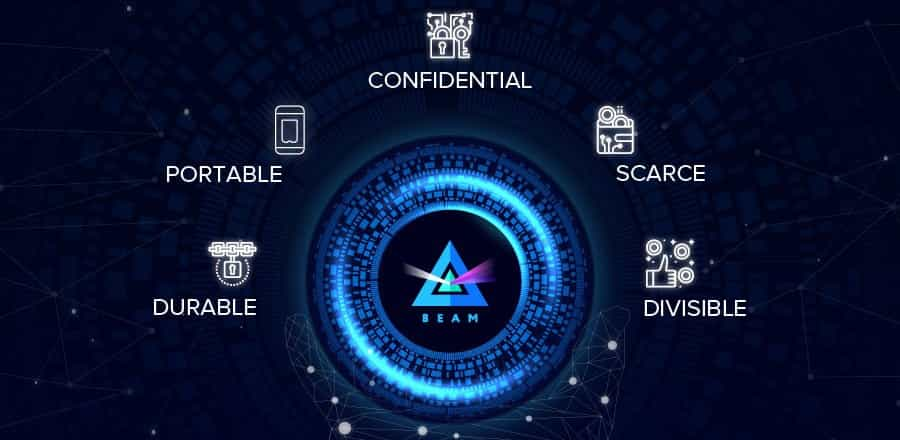
It is one of a number of newer coins based on the Mimblewimble protocol that includes Grin, and was created to help fill what is perceived as shortcomings in the available privacy coins such as ZCash and Monero. There are several features the Beam team have added which they believe will make Beam a superior coin.
Beam Features
Stronger privacy controls are at the top of the list of Beam’s features. It’s believed that other privacy coins have defined a privacy model that only makes transactions private when specifically requested rather than adding privacy by default.
Beam reverses this and makes every transaction private by default. This means users are the only ones capable of determining what information is made publicly available, and keeps complete control of personal data in the hands of the users.
Beam has also introduced the concepts of confidential transactions and confidential assets as an added privacy value feature. This feature will allow for the creation of new digital asset types, such as debt instruments, real estate assets, new currencies, all of which can easily be exchanged privately on the Beam platform.
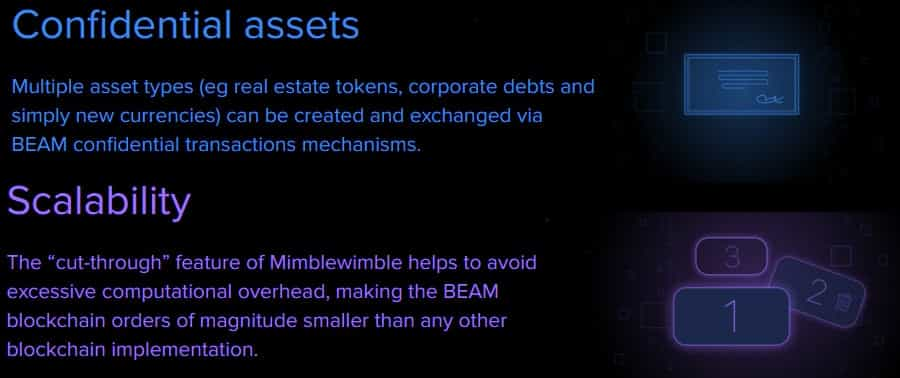
While other blockchains have been struggling with scalability issues, Beam believes they’ve solved the issue by keeping a lean and compact blockchain. Transactions have been designed to avoid bloating, through the use of Mimblewimble protocol to prune old data that’s become irrelevant to current transaction processing needs.
Not only will this reduce bloat it will also reduce computational overhead demands, thus improving network scalability. Beam has been designed to be capable of supporting a variety of transaction types using its Scriptless Script technology. Besides simple value transfers, Beam also supports time-locked transfers, atomic swaps, and escrow payments.
Privacy will remain the top priority, but this feature also complies with existing regulations through the support of unforgeable digital wallet signatures. This will allow authorized auditors to see the full list of transactions and any relevant documentation.
MimbleWimble??
Any discussion of Beam requires a basic understanding of Mimblewimble technology, sine that is the basis for Beam. Mimblewimble is based on the Bitcoin protocol, but modified to improve privacy and the efficiency of the network. The privacy implementation also improves fungibility as a side-effect.
In the Mimblewimble protocol transaction receivers are able to generate a blinding factor when signing a transaction. This is made possible through the use of a combination of Pedersen Commitments and Confidential Transactions.
Although Confidential Transactions need additional proofs with each transaction, making them cumbersome, Mimblewimble sidesteps this by stripping out the scripting behavior. It then combines the above mentioned blinding factors with dummy outputs to achieve the privacy and security levels of Confidential Transactions without the associated performance issues.

Mimblewimble has also streamlined the blockchain by using transaction aggregation that rids us of the need to store most past transaction data. Within Mimblewimble blocks the transactions look like a random mix of outputs and inputs. This allows faster synching of nodes since they need only verify the authenticity of certain recent inputs rather than the entire blockchain.
Mimblewimbles compacted blocks contain the output signatures of the dummy outputs, along with the system state and block headers. This gives us a blockchain protocol with improved privacy and scalability based on its transaction construction method.
The blockchain grows more slowly, avoiding bloat and enabling full nodes to operate more effectively, thus improving the long-term decentralization of the network.
Beam Implementation of Mimblewimble
The only way the Beam coin will successfully achieve both scalability and privacy is through the proper implementation of Mimblewimble.
As a bit of history, the name “Mimblewimble” comes from the Harry Potter series of books, and it is a “Tongue-tying Curse” spell in the books. In August 2016 the first version of the Mimblewimble whitepaper was published by an anonymous cryptographer using the pseudonym “Tom Elvis Jedusor”, which refers to the antagonist Voldemort in the Harry Potter books.

The Mimblewimble vision painted by “Jedusor” has been implemented in both Beam and another coin called Grin, with each taking a different tack in their implementations. In the case of Beam it has aligned with the goals of Mimblewimble and seeks to successfully implement two key features: Confidential Transactions and Transaction Cut-Through.
What Are Confidential Transactions?
Confidential transactions have a hiding feature and a blinding feature provided by Pedersen Commitments in conjunction with Elliptic Curve Cryptography. Using confidential transactions allows users to hide or blind any of the information associated with transactions. This means only the sender and receiver know the transaction amounts.
This is achieved by using blinding factors to encrypt the transaction amounts. The blinding works by assigning a random value and multiplying the actual transaction amount by this random value. This is followed by a single multi-signature being created that covers all the inputs and outputs in the transaction.
When the transaction is received the recipient selects several blinding factors randomly. These can later be used as proof of ownership when it is time to spend the coins.
Beam’s Personal Data Protection
Unlike nearly every blockchain existent, Beam is trying to change the system that records transfers and coin ownership based on addresses. Beam is able to confirm input and output ownership through the blinding factors and values only. The blockchain is used to store just the commitment, which only becomes relevant when wallets need to engage in a transaction.
In addition to the removal of all personal information regarding a transaction, Beam also uses a regular expiration interval of 24 hours. This can be modified through the wallet settings, and the Beam developers recommend users create new receiving addresses for every transaction.
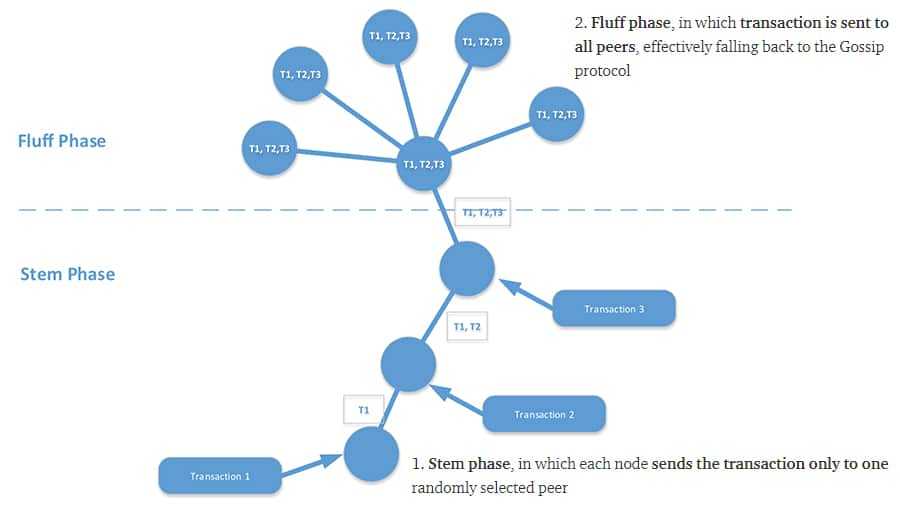
To add even better privacy protections, Beam has implemented the Dandelion Protocol too. You can also find this privacy protection implemented in such blockchains as ZCoin, where it is used to lower the probability that personal data can be linked to addresses and transactions. The Dandelion Protocol allows Beam to support dummy inputs and outputs.
As a final privacy feature, Beam utilizes the Secure Bulletin Board System which permits the exchange of secure encrypted messages between wallets, even if they are not online at the same time.
Beam Monetary Policy
Beam is explicit in stating as part of its monetary policy that it was created as a store of value, not as a transactional cryptocurrency. The supply of Beam will never exceed 263 million BEAM and the coin uses a deflationary emissions scheme similar to that used by Bitcoin in which block rewards are halved over time.
The initial block reward is 80 BEAM, and this will halve roughly every 4 years until it reaches zero in roughly 2152. After that, no more BEAM coins will ever be created.
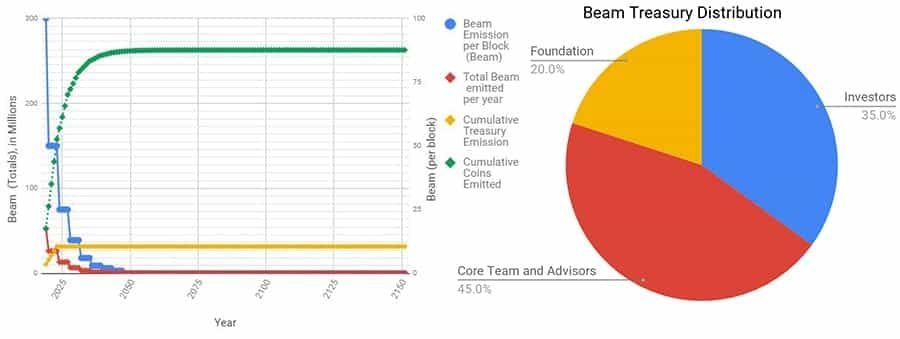
BEAM also uses a model similar to the ZCash Founder’s reward in which a portion of each block reward is paid into the Beam Treasury. Those coins are then paid out monthly to the Beam Foundation, including developers, advisors, and investors. This is how the Foundation finances the ongoing development of Beam. The Treasury reward is 25% of the block reward.
Governance and Community
Beam has followed a corporate type approach to its early funding and governance, where full-time developers and contributors are hired, and funding comes from venture capitalists. The entire project is then overseen by the Switzerland-based non-profit Beam Foundation, which has a mandate to guide the development of the Beam network.
One of the main selling points of Beam, especially for businesses, is its auditing features that will give businesses the ability to provide a financial trail for auditors or regulators if needed. As part of a broader Beam Compliance Initiative there is a focus on third-party services to provide country specific regulation compliance.
The Beam Foundation is actively seeking development partners, and has also sought out venture capital firms willing to make investments into the project. More recently, the Foundation has established the Beam Sovereign Money Foundation, which helps promote and fund the development of Beam.
The BEAM Team
The Beam development team consists of roughly 20 individuals as of this writing, as well as an additional 13 advisors to the project. The CEO is Alexander Zaidelson.
Alexander is a seasoned executive and product visionary. His career began as a software developer, after which he founded Nareos (a P2P File Sharing Company) and Wikitup (acquired by iMesh). He has also served as an advisor to several startup projects.

The CTO of Beam is Alex Romanov. Alex is a Research and Development manager with a strong technical background and managerial skills. Alex has worked on many complex projects with large distributed teams. Romanov leads the R&D Team at Beam since the project was started.
The COO at Beam is Amir Aaronson. Amir is a motivated entrepreneur, and strong-minded operating expert. He’s been a co-founder of several technology companies and has spent the past 2 years deeply immersed in the field of cryptocurrency.
Finally there is CMO Beni Issembert. Beni is a serial entrepreneur for the past 14 years. He is also a lecturer, marketer, writer, and story teller trying to bridge the link between philosophy and technology.
BEAM Coin
The Beam coin has a fairly short history, beginning with the January 17, 2019 mainnet launch and opening price of just over $0.57. Since there was no ICO for the token we can’t be sure what private investors may have paid prior to the mainnet launch.
Price moved higher after the launch of the mainnet, reaching the all-time high of $3.21 on January 28, 2019. It fell off those highs, and by May was also below the opening levels as well. On June 6, 2019 it hit its all-time low of $0.381546.
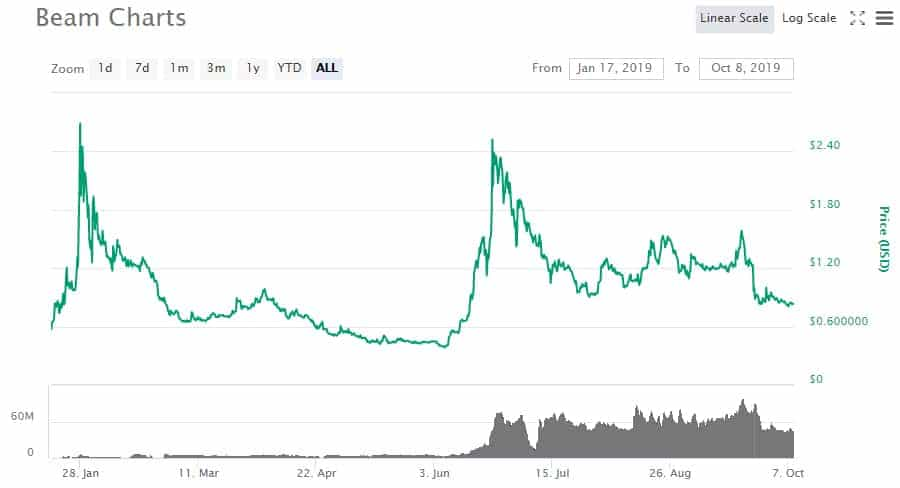
It recovered off the all-time low and has spent most of the rest of its existence above $1, but late September saw it fall below that handle, and as of October 8, 2019 it is trading at $0.826316 and is just out of the top 100 cryptocurrencies by market cap as it rests in position number 101.
Trading & Storing BEAM
For a fairly new coin on the markets, BEAM is available on quite a number of exchanges. For example, it is listed on Binance, DragonEX, Gate.io, BitForex etc.
However, when I looked over 65% of the volume was concentrated for trading on the HotBit exchange. This could pose a risk from a market liquidity perspective at some point in the future. If ever there was a situation in which BEAM trading on HotBit were to stop, it means volumes could drop considerably.
The order books also appear pretty thin on well known exchanges such as the Binance Exchange. For example, if we take a look at the BEAM / BTC books we can see that daily turnover is quite limited and the distribution of the orders themselves are pretty wide.

Once you have your BEAM, you are going to want to take it offline and store it in a wallet. Unfortunately, you are quite limited as to the wallet support for the coin currently. Having said that, integrations are being worked on and Trezor support is around the corner.
For now, your best bet is perhaps to keep your BEAM on is their proprietary native wallet. This is actually available on both desktop and mobile devices. There is also support for a number of different operating systems including Microsoft, Mac, Android, iOS and Linux.
The Beam wallet is pretty intuitive to use and has a host of features. These include things like Atomic Swap, Touch ID / Face ID payment proof and share transaction details. You can download your Beam wallet here.
Beam Keeps Mining Fair
Like Bitcoin, Beam is a Proof-of-Work blockchain, which allows miners to receive rewards for contributing computing power to the network. Beam uses a modification of the Equihash algorithm called Beam Hash II for consensus, calling it a GPU-friendly and stable solution that will lead to equitable distribution of BEAM coins.
One of the goals of the team is to decentralize the Beam network right from the start, and to this end they are discouraging ASIC mining for the first 18 months, and encouraging GPU mining.
The team has no intention of forever blocking ASIC mining, they are just attempting to give GPU miners a headstart at the beginning of the Beam lifecycle. It is also presumed that this method gives an improved hashrate and cryptographic wall.
Beam Development
Something that I really wanted to touch on about Beam is the extent of work that has been done recently on their protocol.
This is something that you can immediately verify by checking into their GitHub repository. These open source repos are a pretty good barometer on how much code is being pushed.
Therefore I decided to dive into the Beam GitHub. Below are the code commits over the past 12 months to the two most active repos.
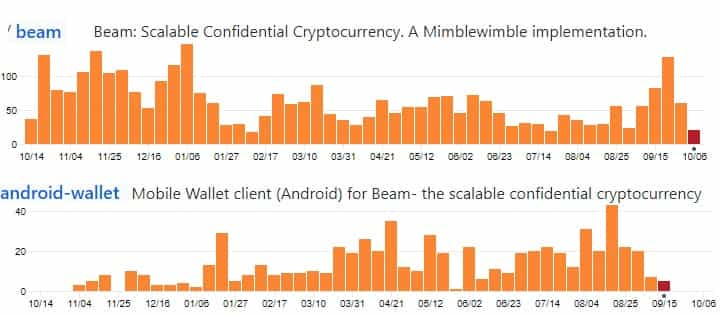
As you can see there have been extensive commits to these repos over the past year. The bulk of this is taking place on their core protocol which is an encouraging sign.
If we were to compare the level of commits to other projects in the space, it comes in at number 10 with over 3,000 core commits.
Indeed this level of development all makes sense if you were to take a look at their development roadmap. Over the past year they have completed the following amoung others:
- Mining Pool API
- Android and iOS Wallets
- Cold Wallet
- Beam to BTC, LTC, QTUM Atomic Swap
- Lightning POC
- Atomic Swaps Marketplace
- PoW Algorithm Change
Moreover, their roadmap still has some important milestones that we can look forward to over the coming 4-6 months. These include the following:
- Ledger & Trezor Support
- Android and iOS Wallets
- Multisig Support
- Confidential Assets on Mainnet
- Lightning POC
- Tor/i2P
If you wanted to keep up to date with the development then you can follow their official blog. You can also head on over to their documentation for some additional "light" reading.
Conclusion
Beam is one of the very first full Mimblewimble implementations, and if carried off successfully it brings substantial improvements in efficiency and privacy. Future plans from the project include even more innovations meant to improve the overall privacy of the cryptocurrency space.
Although Beam is a fairly new addition to the cryptocurrency scene, it has actually been nearly inevitable ever since the first Mimblewimble whitepaper was released on the world in 2016.
It remains quite early in the game for Beam, but as the coin and its community mature it’s fairly certain that a preferred set of applications and users will emerge.
Additional Resources
Disclaimer: These are the writer’s opinions and should not be considered investment advice. Readers should do their own research.
